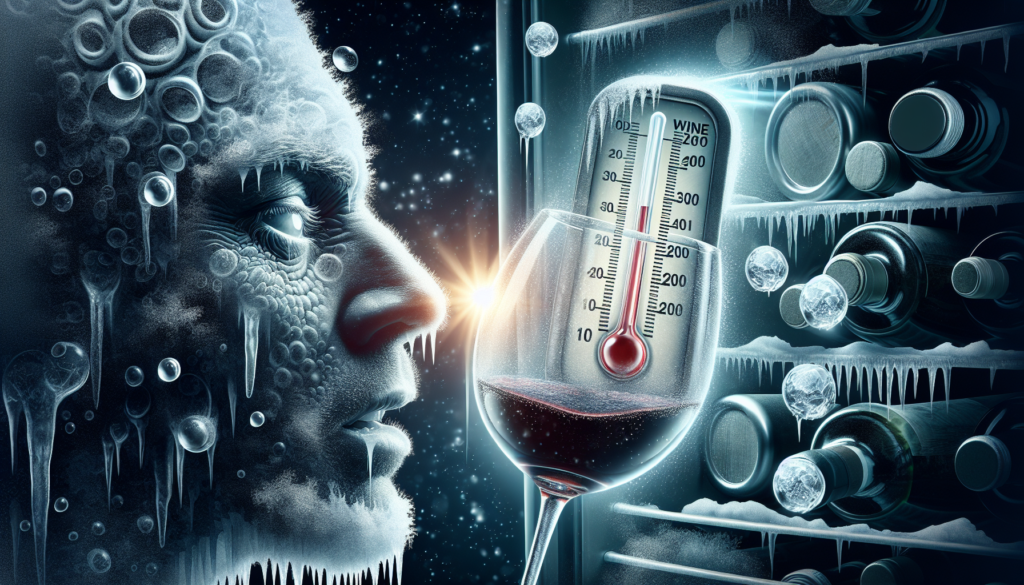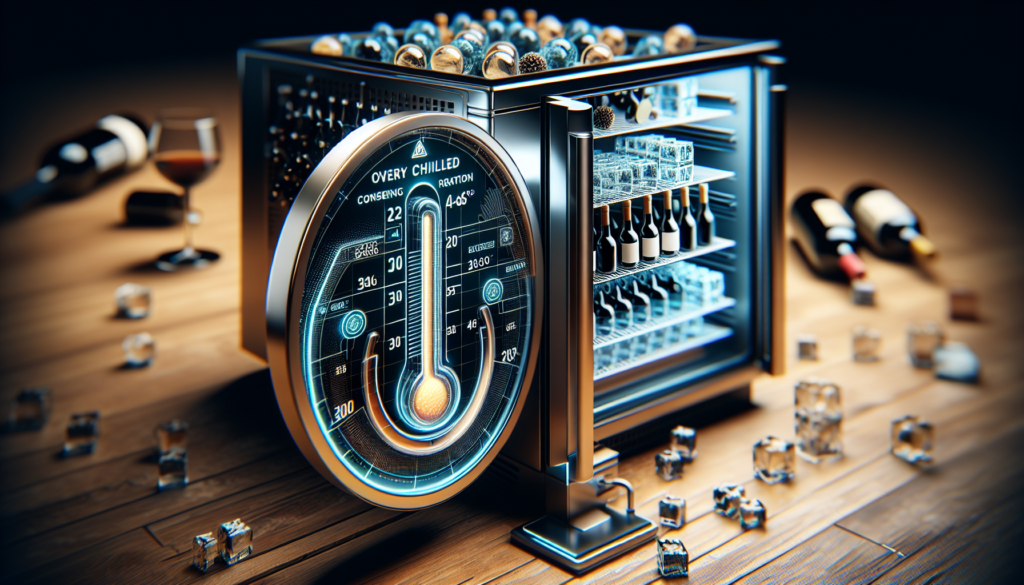Is your beloved wine fridge turning into an icy tundra, threatening the delicate flavors of your cherished bottles? It’s a frustrating issue that wine enthusiasts often face – the struggle of a wine fridge getting too cold. But fret not, as in this article, we’ll explore the reasons behind your excessively cold wine fridge and provide you with some simple solutions to keep your wines at their optimal temperature. So grab your glass and let’s warm up to the answers!
Common Causes for a Wine Fridge Getting Too Cold
1. Faulty Temperature Setting
One of the most common causes for a wine fridge getting too cold is a faulty temperature setting. Sometimes, the temperature dial or control panel may not accurately reflect the actual temperature inside the fridge. This can lead to the wine fridge cooling down to a lower temperature than intended, causing unwanted chilling of your wine bottles.
2. Damaged Thermostat
Another possible cause for a wine fridge getting too cold is a damaged thermostat. The thermostat is responsible for regulating the temperature inside the fridge by cycling the cooling system on and off. If the thermostat is not functioning properly, it may not accurately detect the temperature or control the cooling process, resulting in the wine fridge becoming excessively cold.
3. Blocked Air Vents
Blocked air vents can also contribute to a wine fridge getting too cold. Air vents are crucial for maintaining proper airflow and temperature distribution within the fridge. If these vents become blocked by dust, debris, or even accidentally blocked by placing items too close to the vent area, it can disrupt the natural circulation of cold air and cause the fridge to become colder than desired.
4. Defective Temperature Sensor
A defective temperature sensor can be another reason why a wine fridge is getting too cold. The temperature sensor is responsible for constantly monitoring the temperature inside the fridge and sending signals to the cooling system to maintain the desired temperature range. If the sensor is faulty, it may provide incorrect readings or fail to communicate with the cooling system, resulting in excessive cooling and low temperatures.
Effect of a Wine Fridge Being Too Cold
1. Stunted Aging Process
When a wine fridge is too cold, it can hinder the aging process of your wine. Wine aging is a delicate process that involves controlled temperature conditions. If the temperature inside the fridge drops below the optimal range, it can slow down or completely halt the aging process. This can lead to a loss of complexity, flavor development, and overall maturation of the wine.
2. Flavor Alteration
The excessive cold temperature in a wine fridge can also alter the flavors of your wine. Certain flavors and aromas may become subdued or muted when exposed to extremely low temperatures. The delicate balance of acidity, tannins, and aromatic compounds can be disrupted, resulting in a less enjoyable tasting experience. It’s important to ensure that your wine is stored at the appropriate temperature to preserve its intended flavors.
3. High Chance of Crystallization
When a wine fridge gets too cold, there is a higher chance of crystallization occurring in the wine bottle. Crystallization happens when the wine’s natural sugars and acids solidify, forming crystals. These crystals can negatively impact the taste and texture of the wine. Additionally, if the crystals are large enough, they can even cause corks to become dislodged or create a grainy texture in the wine.

Troubleshooting Steps to Fix a Wine Fridge That’s Too Cold
1. Check and Adjust Temperature Setting
The first troubleshooting step to fix a wine fridge that’s too cold is to check and adjust the temperature setting. Make sure that the temperature dial or control panel is set at the desired temperature range for wine storage. If you suspect that the temperature setting is not accurate, use a separate thermometer to measure the actual temperature inside the fridge and make necessary adjustments accordingly.
2. Inspect and Replace Thermostat
If adjusting the temperature setting does not resolve the issue, the next step is to inspect and potentially replace the thermostat. Carefully examine the thermostat for any signs of physical damage or malfunction. If you notice any irregularities, such as loose wires or a visibly damaged thermostat, it may need to be replaced. Consult the manufacturer’s instructions or seek professional help to ensure a proper replacement.
3. Ensure Proper Airflow by Clearing Vents
To fix a wine fridge that’s too cold, it’s essential to ensure proper airflow by clearing any blocked vents. Carefully inspect the vents for any obstructions, such as dust, debris, or objects placed too close to the vent area. Use a soft brush or vacuum cleaner to gently remove any accumulated debris. Restoring unrestricted airflow will help maintain a consistent and appropriate temperature throughout the fridge.
4. Test and Replace Faulty Temperature Sensor
If the previous troubleshooting steps do not resolve the issue, it may be necessary to test and replace the faulty temperature sensor. Consult the manufacturer’s instructions or seek professional help to accurately test the sensor’s functionality. If it is determined that the temperature sensor is defective, it should be replaced with a new one compatible with your wine fridge model.
Preventive Measures for Maintaining Optimal Wine Fridge Temperature
1. Regularly Monitor and Adjust Temperature
To maintain optimal wine fridge temperature, it is important to regularly monitor and adjust the temperature settings. Use a separate thermometer to periodically check the internal temperature of the fridge and make necessary adjustments if needed. Keeping a close eye on the temperature will help ensure that your wine is stored within the recommended temperature range for proper aging and preserving flavor.
2. Clean and Maintain the Wine Fridge
Proper cleaning and maintenance of the wine fridge can contribute to maintaining optimal temperature conditions. Regularly clean the interior of the fridge, including shelves, racks, and walls, to remove any spills, stains, or residue. Additionally, ensure that the seals and gaskets are clean and in good condition to maintain an airtight seal, preventing any outside air from affecting the temperature inside.
3. Monitor Ambient Temperature
The surrounding ambient temperature can also impact the performance of a wine fridge. Ensure that the wine fridge is placed in an area with a relatively stable temperature, away from direct sunlight, heat sources, or extreme fluctuations. Fluctuations in ambient temperature can affect the cooling efficiency and put additional strain on the wine fridge’s temperature regulation, resulting in inconsistent or excessively cold temperatures.

When to Seek Professional Help
1. Persistent and Unresolved Cooling Issues
If you have tried the troubleshooting steps mentioned earlier and are still experiencing persistent and unresolved cooling issues with your wine fridge, it may be time to seek professional help. A certified technician or wine fridge specialist can diagnose the problem more accurately and provide the necessary repairs or replacements to restore proper functioning.
2. Electrical or Mechanical Failures
In cases where there are evident electrical or mechanical failures within the wine fridge, it is best to seek immediate professional assistance. These failures may be beyond the scope of DIY troubleshooting and may require specialized knowledge and tools to repair. Attempting to fix complex electrical or mechanical issues without proper expertise can lead to further damage or voiding of warranty.
3. Lack of Technical Expertise
If you are unfamiliar with the technical aspects of wine fridge repair and lack the necessary expertise or confidence to troubleshoot and fix the problem yourself, it is advisable to seek professional help. Professional technicians have the knowledge, experience, and resources to accurately diagnose and address any issues with your wine fridge, ensuring that it operates optimally and at the appropriate temperature.
